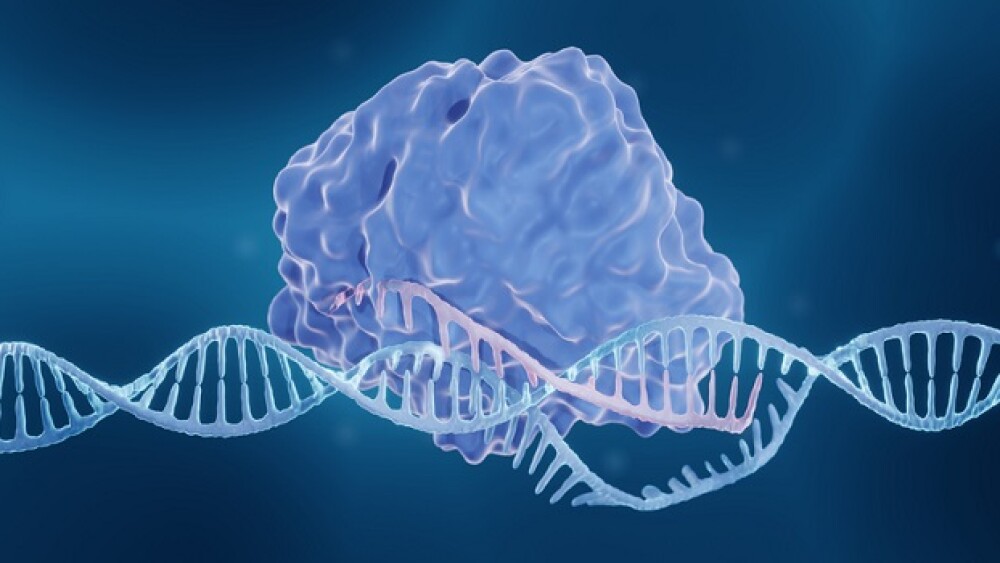Gene editing technologies are advancing rapidly in the clinic, with the potential first approval later this year, but challenges remain.
Pictured: CRISPR-Cas9 genome editing enzyme/iStock, Artur Plawgo
Hereditary angioedema patients treated with Intellia’s NTLA-2002—an in vivo CRISPR-Cas9 therapy— had an average 95% reduction in the sudden, debilitating bouts of swelling that are a hallmark of the disease, with some patients remaining attack-free for more than a year, according to updated Phase I data presented in June. But despite the potential of gene editing to ease or even cure genetic diseases, questions about the safety and efficacy of the techniques remain.
Previous CRISPR trials have resulted in adverse side effects or, rarely, even death. In May, a participant in an N-of-1 Duchenne muscular dystrophy trial died after potentially reacting to the virus carrying the gene-editing therapy.
When injected systemically, the liver takes up many gene editing delivery vectors. While most delivery vectors are well-tolerated in most people, at high doses, some can drive inflammation that can lead to toxicity. Designing vectors that reach organs besides the liver has posed significant hurdles for scientists. Another danger is off-target effects, where the editors inadvertently change portions of the healthy genetic code.
Despite these limitations, innovations in delivery methods and next-generation CRISPR technologies—such as base and prime editing—may increase the types of diseases that can be targeted and treated with gene editing.
Kiran Musunuru, a cardiologist at the University of Pennsylvania, told BioSpace that while still early, the results look promising for the limited number of patients who have received Intellia’s drug.
CRISPR Reaches the Clinic
CRISPR has advanced quickly since the technology was first invented 10 years ago. In a landmark decision expected later this year, the FDA could approve an ex vivo gene editing therapy for sickle cell disease (SCD). The biologics license applications—submitted in April for exagamglogene autotemcel (exa-cel) in SCD and transfusion-dependent beta thalassemia (TDT) by Vertex and CRISPR Therapeutics—were the first CRISPR gene editing filings to be accepted by the FDA. The regulator has set PDUFA dates of December 8, 2023, and March 30, 2024, respectively.
“The first FDA approval of a new type of technology—in this case, programmable gene editing drugs—is a huge milestone,” David Liu, a molecular biologist at the Broad Institute and Harvard professor, told BioSpace.
There are more than 50 in-human clinical trials for both in vivo and ex vivo gene editing technologies in the early stages, Liu said, and roughly 40 are CRISPR-based. These therapies are being tested for blood disorders, cancer, chronic infection, liver diseases, immune deficiencies and more.
But the in vivo space has progressed more slowly. The first patient to receive an in vivo CRISPR therapy did so in 2020 in a clinical trial for Editas Medicine’s treatment for Leber Congenital Amaurosis (LCA), a type of genetic blindness caused by a single nucleotide change in a retinal photoreceptor gene.
After treatment with EDIT-101, some patients had some visual acuity and a few had regained their ability to see color, according to an Editas press release issued in November 2022. None had adverse effects. While the therapy worked well for some patients, it failed in roughly half, and Editas eventually pulled the plug on the Phase I/II trial.
That means Intellia is the only company that has presented clinical data for in vivo trials that have met primary endpoints and the only company that has started Phase II trials, David Lebwohl, the company’s chief medical officer, told BioSpace.
Musunuru and Liu agreed that Intellia’s treatment appears to work well, but due to its delivery method through lipid nanoparticles (LNPs), NTLA-2002 is limited to treating rare diseases that originate in the liver. If delivered intravenously, LNPs are taken up by the liver, which is true for many other delivery vectors for in vivo gene editing studies, Musunuru said.
The therapy also uses the original CRISPR-Cas9 system, which Musunuru said is useful for turning off genes, “but there is a limited set of diseases for which turning off a gene is therapeutically useful.”
Base and Prime Editing
CRISPR-Cas9 was first developed by Jennifer Doudna’s lab at the University of California, Berkeley. Since then, base editing and prime editing have expanded the number of diseases that gene editing can potentially target.
The CRISPR-Cas9 system works by cleaving the DNA double helix at a specific nucleotide sequence, Liu explained. Cas9, a nuclease, cuts the cell’s DNA at a specific location, after which the cell’s endogenous repair enzymes glue the strands back together. Cas9 keeps cutting the DNA at the same location until, by chance, the cell’s repair machinery makes a mistake and inserts the wrong nucleotide.
The result is a genetically edited sequence of DNA, which Cas9 no longer recognizes. But crucially, you can’t control what the cell inserts, Liu said. This technology often works well if you want to eliminate the function of a dysfunctional protein but less so if you’re looking to replace a defective gene.
CRISPR-Cas9 has advantages. It is very modular, Lebwohl said, which allowed Intellia to change only a messenger RNA (mRNA) sequence to enable a whole new therapy.
However, Liu said one major limitation of this technology is that it causes double-stranded breaks, leading to unfavorable mutations and off-target effects. On the other hand, prime editing and base editing rely on simply nicking one strand of the double helix, allowing researchers to edit DNA without double-stranded breaks and potentially making them safer. “It’s estimated that every human cell undergoes maybe 10,000 nicks a day because nicking is a natural part of DNA repair and DNA replication,” he said.
Liu, who co-founded Prime Medicine and Beam Therapeutics—both gene editing companies—said base editing allows scientists to substitute certain single DNA nucleotides, which could enable the development of drugs for diseases caused by point mutations—where one single nucleotide base is added, deleted or changed.
This makes base editors well-suited to treat some forms of glycogen storage disease and one form of beta-thalassemia, both of which can occur due to pathogenic single nucleotide polymorphisms.
However, base editors can only change purines to purines and pyrimidines to pyrimidines and are vulnerable to also changing neighboring nucleotides. Older versions of the tech can have off-target effects on other portions of the DNA, Liu added, due to the promiscuous activity of the deaminase enzyme, which helps convert nucleotides to other nucleotides during base editing.
Prime editors allow researchers to replace stretches of genes and perform a diverse range of substitutions, insertions, and deletions, Liu said. They are extremely specific but less efficient than the other technologies.
“Prime editors are highly versatile,” Liu said. “Current generation prime editors can basically replace any DNA segment up to several hundred base pairs with any DNA segment [of the same length].” Because they allow researchers to insert long DNA sequences into cells, such technologies could be used to treat diseases such as Tay Sachs, caused by a large deletion mutation.
CRISPR-Cas9, prime editing and base editing have been validated in animal models of human genetic disease, and the CRISPR-Cas9 and base editing have now entered human clinical trials. Liu said he expects Prime Medicine’s technology to reach the clinic next year.
The Delivery Dilemma
Musunuru said delivery is the area where innovation is most needed. Many in vivo therapies have targeted the eye and the liver, mainly due to the ease of vector delivery.
Once they enter the blood, LNPs and other delivery vectors—including adeno-associated viruses (AAVs)—get sucked up by the liver, Lebwohl said. They can efficiently deliver gene therapies to hepatocytes, but other organs have proven more difficult.
Viral vectors can be engineered to target specific cells but are immunogenic and potentially toxic at high doses, Liu said. Recently, scientists have begun designing AAVs specifically targeting organs such as the muscles so they can be used at lower doses. Researchers are also improving non-AAV technologies, searching for ways to get past the blood-brain barrier and potentially target the brain.
Lebwohl said Intellia expects to move to Phase III with NTLA-2002, but the company is still in the early stages of Phase II recruiting, which means it may be years before the therapy is approved. Whether NTLA-2002—and CRISPR-Cas9-based treatments in general—are well-tolerated long-term requires follow-up studies, he said. “We’re talking about five, six, seven decades of patients not needing a drug if this holds up in the long run.”
While there is still much work to be done, Liu said FDA approval of the first CRISPR gene editing therapy would represent a major step for humanity as it would mean humans have some say in their genetic features and are not held hostage by mutations.
Natalia Mesa is a freelance science writer based in Seattle. Reach her at natalia.mesa.v@gmail.com.







